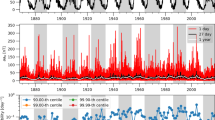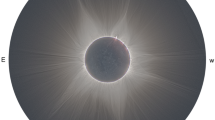Abstract
This paper summarizes current helicity measurements in the solar active regions (ARs). There is a basic agreement with the “hemispheric sign rule (HSR)” of the current helicity among different vector magnetographs through two solar cycles, but there is a large dispersion of the fraction of ARs following the HSR. In our sample, there are 50%–78% ARs in solar cycle 22 and 44%–79% ARs in cycle 23 following the HSR. A variation is also found in the fraction of the ARs following the HSR between different instruments even when the same ARs are selected. The difference also exists for the same instrument when the selected ARs are different. There are some differences in the variation of HSR with solar cycle for the individual helicity parameter inferred from different instruments. Factors which influence the correlation of different data sets are analyzed.
Similar content being viewed by others
References
Bao S D, Zhang H Q. Patterns of current helicity for solar cycle 22. Astrophys J, 1998, 496: L43–L46
Pevtsov A A, Canfield R C, Metcalf T R. Latitudinal variation of helicity of photospheric magnetic fields. Astrophys J, 1995, 440: L109–L112
Hagino M, Sakurai T. Latitude variation of helicity in solar active regions. Publ Astron Soc Jpn, 2004, 56: 831–843
Seehafer N. Electric current helicity in the solar atmosphere. Sol Phys, 1990, 125: 219–232
Kleeorin N, Kuzanyan K, Moss D, et al. Magnetic helicity evolution during the solar activity cycle: Observations and dynamo theory. Astron Astrophys, 2003, 409: 1097–1109
Zhang H, Sokoloff D, Rogachevskii I, et al. The radial distribution of magnetic helicity in the solar convective zone: Observations and dynamo theory. Mon Not Roy Astron Soc, 2006, 365(1): 276–286
Abramenko V I, Wang T J, Yurchishin V B. Analysis of electric current helicity in active regions on the basis of vector magnetograms. Sol Phys, 1996, 168(1): 75–89
Longcope D W, Fisher G H, Pevtsov A A. Flux-tube twist resulting from helical turbulence: The sigma-effect. Astrophys J, 1998, 507(1): 417–432
Bao S D, Ai G X, Zhang H Q. The hemispheric sign rule of current helicity during the rising phase of cycle 23. J Astrophys Astron, 2000, 21: 303–306
Pevtsov A A, Canfield R C, Latushko S M. Hemispheric helicity trend for solar cycle 23. Astrophys J, 2001, 549(2): L261–L263
Ai G X, Hu Y F. The propose for the solar magnetic field telescope and its working theorem. Acta Astron Sin, 1986, 27(2): 173–180
Sakurai T, Koyoshi K, Nishino Y, et al. Solar flare telescope at Mitaka. Publ Astron Soc Jpn, 1995, 47: 81–92
Mickey D L. The Haleakala Stokes polarimeter. Sol Phys, 1985, 97: 223–238
Ronan R S, Mickey D L, Orrall F Q. The derivation of vector magnetic fields from Stokes profiles - integral versus least squares fitting techniques. Sol Phys, 1987, 113: 353–359
Xu H Q, Gao Y, Zhang H Q, et al. Helicity comparison among three magnetographs. Adv Space Res, 2007, 39(11): 1715–1722
Bao S D, Pevtsov A A, Wang T J, et al. Helicity computation using observations from two different polarimetric instruments. Sol Phys, 2000, 195(1): 75–87
Zhang H Q, Labonte B, Li J, et al. Analysis of vector magnetic fields in solar active regions by Huairou, Mees and Mitaka vector magnetographs. Sol Phys, 2003, 213(1): 87–102
Pevtsov A A, Dun J P, Zhang H Q. Helicity measurements from two magnetographs. Sol Phys, 2006, 234(2): 203–212
Zhang H Q, Bao S. Longitudinal distribution of current helicity and solar activities. Astrophys J, 1999, 519(2): 876–883
Hagino M, Sakurai T. Solar-cycle variation of magnetic helicity in active regions. Publ Astron Soc Jpn, 2005, 57: 481–485
Choudhuri A R, Chatterje P, Nandy D. Helicity of solar active regions from a dynamo model. Astrophys J, 2004, 615: L57–L60
Zhang H Q. Analysis of the transverse magnetic field in solar active regions by the Huairou vector magnetograph. Sol Phys, 2000, 197: 235–251
Su J T, Zhang H Q. Diagnosis of Faraday rotation with the video vector magnetograph at Huairou. Sol Phys, 2004, 222(1): 17–33
Gao Y, Xu H Q, Zhang H Q. Probing the method of correcting Faraday rotation in vector magnetograms. Adv Space Res, 2008, 42(5): 888–894
Gao Y, Su J T, Xu H Q, et al. Statistical removal of Faraday rotation in vector magnetograms taken by filter-type magnetographs. Mon Not Roy Astron Soc, 2008, 386(4): 1959–1965
Parker E N. Hydromagnetic dynamo models. Astrophys J, 1955, 122: 293–314
Kuzanyan K, Bao S D, Zhang H Q. Probing signatures of the alpha-effect in the solar convection zone. Sol Phys, 2000, 191: 231–246
Sokoloff D, Bao S D, Kleeorin N, et al. The distribution of current helicity at the solar surface at the beginning of the solar cycle. Astron Nachr, 2006, 327: 876–883
Kuzanyan K, Lamburt G, Zhang H Q, et al. Distribution of helical properties of solar magnetic fields. Chin J Astron Astrophys, 2003, 3: 257–265
Xu H Q, Gao Y, Popova H P, et al. Magnetic and electriccurrent helicities in very simple models of the solar dynamo. Astron Rep, 2009, 53(2): 160–165
Author information
Authors and Affiliations
Corresponding author
Additional information
Supported by the National Natural Science Foundation of China (Grant Nos. 10611120338, 10473016, 10673016, 60673158, 10733020, and 10978015), the National Basic Research Program of China (Grant No. 2006CB806301), and the Important Directional Project of Chinese Academy of Sciences (Grant No. KLCX2-YW-T04)
Rights and permissions
About this article
Cite this article
Xu, H., Gao, Y. & Zhang, H. Some basic questions on helicity inferred from vector magnetograms. Sci. China Ser. G-Phys. Mech. Astron. 52, 1749–1753 (2009). https://doi.org/10.1007/s11433-009-0246-3
Received:
Accepted:
Published:
Issue Date:
DOI: https://doi.org/10.1007/s11433-009-0246-3




